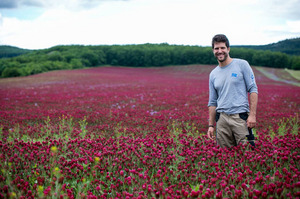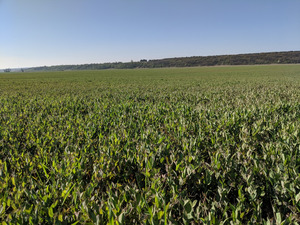Crop diversification experiences at Csoroszlya Farm in Hungary
At the beginning, Csoroszlya farm was a conventional farm with a normal cultivation pattern, and classic crops like sunflower, wheat and canola. After several years of studying subjects related to organic farming, the owners started the transition process into organic at the end of 2015, and in 2018 they already had organic status.
The maintenance of ecosystems and organic farming in this area seemed to be a suitable model for their farm. The farm is located at the foot of the Vértes (an area with hills) and the farmland is in one block. There are mostly forest strips and some grasslands in the area. There are only two conventional farms surrounding these fields, resulting in minimal contact to Csoroszlya farms fields: about 15% of these farmlands have common borders.

Source: feol.hu

Source: Csoroszlya farm, 2020
Problem encountered
When it comes to biodiversity, it bothered Csoroszlya farm to see the same crops everywhere: wheat-corn-sunflower in continuous rotation, and they were aware of plant protection and soil health problems caused by cultivating the same intensive crop every 2-3 years. They wanted to show that a more colourful picture was possible as the farmland has really good potential for this. Furthermore, they really wanted to integrate leguminous crops, thus contributing to soil protection and the enhancement of biodiversity.
Solutions implemented
At the beginning, Csoroszlya farm followed simple patterns. There was a basic scheme where local characteristics and the plants that are adaptable to these were considered and integrated in their crop rotation plan, using examples they had seen abroad. It was very important from the beginning, that they always have flowering plants on their territory. At the beginning there was mustard and buckwheat, and in between there was phacelia (purple tansy). Csoroszlya farm wanted to make sure that there was always something blooming in the territory to attract the bees and the natural predators, therefore increasing biodiversity. When it comes to grains, winter wheat is still a cornerstone grain for them; they have quite a large territory and the market for winter wheat is among the most stable. Therefore, it was obvious that they had to include wheat in the rotation, as they need to be able to sell what they cultivate. Today they are cultivating 265 hectares with 8-10 types of crops such as rye, spelt, triticale and crimson clover and at least 25% percent of the fields have leguminous plants such as peas.
Challenges encountered
At the beginning they grew 10 species and it turned out to be a lot. This was due to the harvesting slightly overlapping between crops. It was difficult because they planned when to harvest each crop, but last year, for example, was quite unpredictable with the dry season in the summer, so the harvesting of each crops overlapped and they had to do it all by themselves. In the future they will plan the crop rotation system so that they do not have to harvest everything in the same time, taking care of storage themselves. Keeping agrodiversity and having lots of varieties comes with difficulties such as increase in workload and more attention needed. At the beginning, they also lacked experience. But with the experiences of the previous years, they can successfully manage all these challenges now. They also plan to invest in their own crop cleaning system which will contribute to further development.
Why was it successful?
Different crops not only contribute to soil and plant health but also to the maintenance of biodiversity and protection of pollinators. Introducing flowering legumes into the crop rotation was a key aspect at the planning stage. Csoroszlya farm aimed for about 25-30% of leguminous plants. There has been positive outcomes: first of all they had no serious troubles with plant protection, except the first year when they had some trouble with the mustard, but in general there was no serious issues. This year they have also trialled an intercropping system with peas and spelt and started to cultivate crimson clover to overcome lack of organic manure and with the intention of seed trading.
 tap and then scroll down to the Add to Home Screen command.
tap and then scroll down to the Add to Home Screen command.